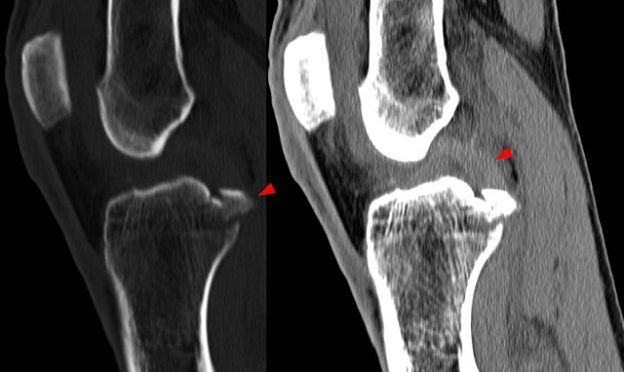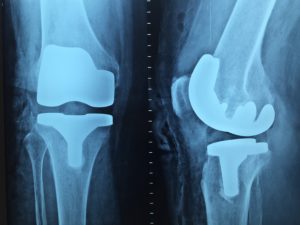Knee Pain — History Taking and Physical Examination
Table of Contents
- History Taking from a Patient Complaining of Acute Knee Pain
- Physical Examination of the Acutely Painful Knee
- When to Order an X-ray and What to look for in a Knee X-ray
- Laboratory Tests in a Patient with Acute Knee Pain
- Acute Septic Arthritis of the Knee
- Gout as a Cause of Acute Knee Pain
- References
Image: “knee CT” by Hellerhoff. License: CC BY-SA 3.0
History Taking from a Patient Complaining of Acute Knee Pain
When a patient presents to the clinic complaining of knee pain, it is essential to characterize the pain. It is important to know if the pain’s onset was rapid or gradual. The location of pain can also give a clue about the most probable cause. Duration, severity, and quality of pain are also important characteristics that should be explored in history taking.
Acute knee pain can be accompanied with an effusion. The timing and amount of the effusion can give important clues to the diagnosis.
Finally, one should inquire about the use of over-the-counter medication or prescribed medication for the control of acute knee pain.
Physical Examination of the Acutely Painful Knee
Examine both knees
It is crucial to examine both knees in the patient. You should always compare the affected side to the other apparently normal side. In the inspection, one should look for signs of acute traumatic injury of the knee. Bruising and discoloration should be noted.
Tenderness and palpation
The knee should be palpated. Tenderness, warmth, and effusions can be assessed with palpation. Point tenderness is an important part of the musculoskeletal examination of the knee. The patella, tibial tubercle, patellar tendon, quadriceps tendon, and the different joint lines should be checked for point tenderness. The range of motion should also be checked. The knee should be able to extend to zero degrees and flex up to 135 degrees.
Different tests
The suprapatellar pouch should be milked in the patient to exclude the presence of a knee effusion. The anterior cruciate ligament should be examined. The anterior drawer test is specific and sensitive for anterior cruciate ligament injuries. The posterior drawer test can be used to assess the integrity of the posterior cruciate ligament.
The medial collateral ligament can be assessed by the valgus stress test. The varus stress test, on the other hand, is used to assess the lateral collateral ligament. Injuries to cruciate or collateral ligaments can also present with an acute knee effusion and point-tenderness. The menisci should also be checked in any patient presenting with a crushing injury to the knee.
When to Order an X-ray and What to look for in a Knee X-ray
Image: “X-ray Knee” by Andersonvr. License: CC BY-SA 1.0
Most cases of acute knee pain are attributed to soft-tissue injuries rather than bony structure injuries; therefore, an X-ray should be ordered only if you suspect with high certainty a bony injury. Ottawa knee rules for obtaining radiographs in acute knee injury can be used to determine if the patient should get an X-ray or not. Pittsburgh knee rules can be also used to determine if the patient needs a knee X-ray. The following table summarizes the rules one can use to determine if an X-ray should be ordered for a patient with acute knee pain.
When an X-ray is performed, one should order three views for the sufficient evaluation of the knee – an anteroposterior view, a lateral view, and a Merchant’s view. The X-ray is ordered to exclude fracture of the patella, tibial plateau, tibial spines, proximal fibula, and femoral condyles.
Laboratory Tests in a Patient with Acute Knee Pain
Laboratory investigations are rarely needed in the acute setting of a knee injury. Children with an acute knee injury, especially those with hemophilia, should undergo a complete blood count to exclude anemia. Patients with inflammatory knee pain, i.e. rheumatoid arthritis or gout, should undergo a complete blood count, erythrocyte sedimentation rate, and uric acid level testing.
Traumatic Knee Injuries and Acute Knee Pain
Anterior cruciate ligament sprain, medial collateral ligament sprain, lateral collateral ligament sprain, and meniscal tears are the most commonly encountered traumatic injuries to the knee. The following table summarizes important characteristics that are specific for each type of injury that can present with acute knee pain.
Acute Septic Arthritis of the Knee
Acute septic arthritis is more common in diabetics, alcoholic patients, and patients with an impaired immune system. Acquired immunodeficiency syndrome, malignancies, and immunosuppressive therapy are important risk factors for septic arthritis.
A physical examination reveals a warm and tender knee. The range of motion is extremely restricted. The joint is very tender to palpation and joint effusion is a common finding.
Arthrocentesis reveals a white blood cell count higher than 50,000 per mm3. 75% of leukocytes in the effusion are polymorphonuclear cells. Because septic arthritis is caused by a bacterial etiology, protein content is usually elevated, whereas glucose is lowered. Gram stain can reveal the causative pathogen. Erythrocyte sedimentation rate and serum white blood cells are usually elevated.
Gout as a Cause of Acute Knee Pain
The patient presents with acute pain, swelling and erythema of the joint without previous history of trauma. The joint is tender to palpation and warm. Almost complete loss of range of motion because of exquisite pain.
Arthrocentesis is indicated to exclude septic arthritis and confirm the diagnosis of gout. White blood cells count from the arthrocentesis ranges between 2000 and 75,000 per mm3. In contrast to septic arthritis, both protein content and glucose are elevated in the effusion in gout. Polarized-light microscopy is useful in confirming the diagnosis. Negatively birefringent rods are the main finding on polarized-light microscopy of the synovial fluid from an affected knee in gout. Laboratory investigations might reveal hyperuricemia; however, uric acid levels might be normal or even low in an acute gouty attack.


knee injury - knee injury - Knee injuries are the nuisance of runners, so you must do some critical things to help defend yourself against them. While these methods won’t give assurance that you won’t get injuries.
ResponderEliminarAm Abdul Hakim so joyful giving this testimony of genius herbalist,Dr Moses anabic herbal home whom cured me of liver cancer.i was diagnosed of liver cancer 2years back I tried to cope with the sickness but unfortunately it had gone so bad,I went to so many medical centres I was told to go for a special xray which was computed tomography scan.it's result came out that my liver was rottening and was told that there was no cure,I collapsed there at the centre after getting myself an individual who came for a test after being cured from hiv,then gave me an email address of dr Moses anabic so I contacted him and he assured me of a total cure after three weeks of administering his herbs and I was cured totally.nothing is impossible for God almighty any individual suffering from any illness or virus no matter how bad it may be,don't ever think it's impossible.contact him through his personal email address via MOSESANABIC@GMAIL.COM or write him on WhatsApp with +2348100661264.thank you very much doctor Moses.
EliminarPrompt and effective diagnosis and treatment for common knee problems depend on practitioners' ability to distinguish between traumatic and inflammatory knee conditions. Looking for the best joint replacement surgeon in Mumbai for shoulder/knee related complications?
ResponderEliminar